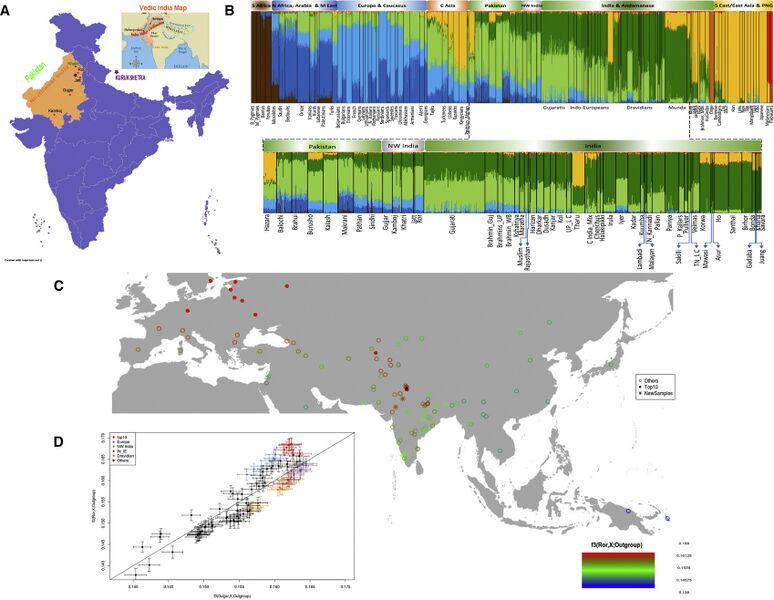File:Sampling Locations, ADMIXTURE, and Shared Drift in Northwest India.jpg

Original file (3,396 × 2,631 pixels, file size: 1.12 MB, MIME type: image/jpeg)
Summary
Figure: Sampling Locations, ADMIXTURE, and Shared Drift in Northwest India
(A) The geographic distribution and sampling locations of newly reported modern samples from Northwest India. An inset shows a map of Vedic India. Dots denote the samples studied, and green color indicates samples from published literature.
(B) Results of ADMIXTURE analysis at K8 ancestral components with global populations. The populations are ordered geographically in a bar plot. The genetic structure of new Northwest Indians is shown with a zoom-in on South Asia. The abbreviations are as follows: S Africa, sub-Saharan Africa; N Africa, North Africa; C Asia, Central Asia; NW India, Northwest India; C India_Mix, Central India Mix (Gond individuals together with one individual each from Bhunjia and Bengali); S East Asia, Southeast Asia; PNG, Papua New Guinea; Munda, Indian Austroasiatic speakers; UP_LC, Uttar Pradesh low-caste groups; TN_LC, Tamilnadu low-caste groups; N_Kannadi, North Kannadi; P_Kallars, Piramalai Kallars.
(C) Outgroup f3 (Ror, X; Yoruba) gradient map, showing the affinity of the Ror to Eurasian populations. Red color indicates populations that have a high affinity with the Ror, green indicates groups that have a medium affinity, and blue indicates groups that have the least affinity with the Ror. The filled red circle shows the top 10 populations that share the highest amount of drift with the Ror. The star indicates the newly sampled population group, and the black star refers to the location of the Ror population.
(D) A scatterplot for outgroup f3 (Ror, X; Yoruba) versus outgroup f3 (Gujjar, X; Yoruba) plots the relative shared drift of West Eurasian populations with the Ror against the drift shared with the Gujjar. The top 10 populations sharing the most drift with the Ror are in red, and they are mostly from Europe. Other populations include Indian Austroasiatic, Central Asian, Pakistani, and Middle Eastern population groups. Abbreviations are as follows: NW India, Northwest India; IN_IE, Indian Indo-Europeans; and Dravidians, Indian Dravidians. Error bars represent jack-knife standard errors.
Attribution:
Source: Journal: The American Journal of Human Genetics (Volume 103, Issue 6); Article: The Genetic Ancestry of Modern Indus Valley Populations from Northwest India (Pages 918–929); Page 919; Published: 06 December 2018 (via Cell Press)
Source–URL of Image: https://www.cell.com/ajhg/fulltext/S0002-9297(18)30398-7
File history
Click on a date/time to view the file as it appeared at that time.
| Date/Time | Thumbnail | Dimensions | User | Comment | |
|---|---|---|---|---|---|
| current | 06:55, 17 July 2022 |  | 3,396 × 2,631 (1.12 MB) | HardeepMoar (talk | contribs) | Source (Attribution): Journal: The American Journal of Human Genetics (Volume 103, Issue 6); Article: The Genetic Ancestry of Modern Indus Valley Populations from Northwest India (Pages 918–929); Page 919; Published: 06 December 2018 (via Cell Press) Source–URL of Image: https://www.cell.com/ajhg/fulltext/S0002-9297(18)30398-7 DOI: https://doi.org/10.1080/03014460.2020.1772877 |
You cannot overwrite this file.
File usage
The following page uses this file: